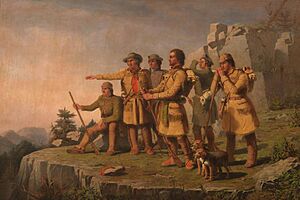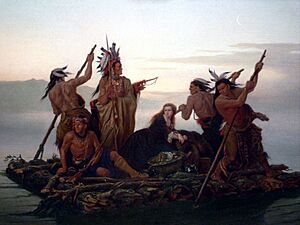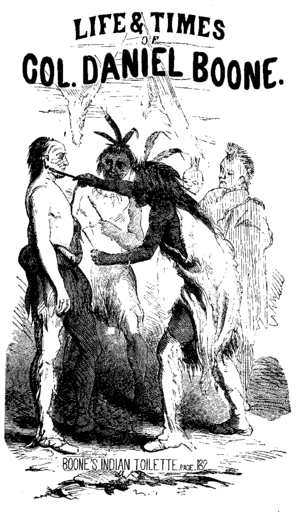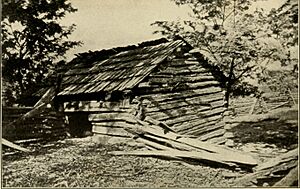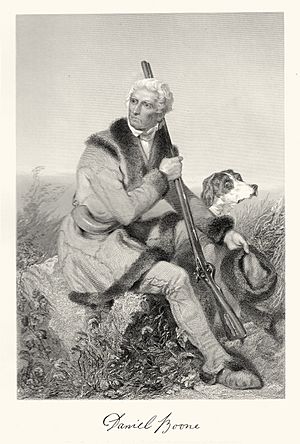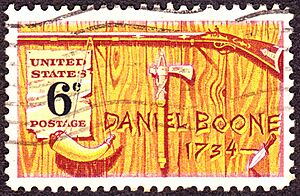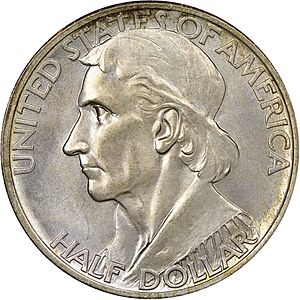Daniel Boone facts for kids
Quick facts for kids
Daniel Boone
|
|
|---|---|
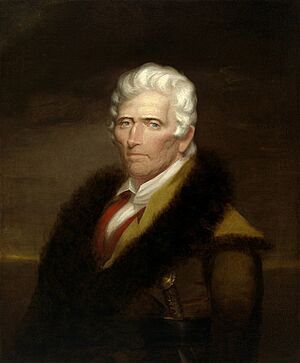
Boone depicted in an 1820 portrait by Chester Harding, the only known portrait of him made during his lifetime
|
|
| Member of the Virginia House of Delegates |
|
| In office October 1791 – December 1791 |
|
| Constituency | Kanawha County |
| In office October 1787 – December 1787 |
|
| Constituency | Bourbon County |
| In office October 1781 – December 1781 |
|
| Constituency | Fayette County |
| Personal details | |
| Born | November 2, 1734 Oley Valley, Province of Pennsylvania, British America |
| Died | September 26, 1820 (aged 85) Defiance, Missouri Territory |
| Resting place | Frankfort Cemetery, Frankfort, Kentucky, or Old Bryan Farm Cemetery, Marthasville, Missouri |
| Spouse | |
| Children | 10, including Jemima, Daniel, and Nathan |
| Relatives |
|
| Occupation |
|
| Signature | |
Daniel Boone (November 2, 1734 – September 26, 1820) was a famous American pioneer and frontiersman. He became one of the first folk heroes of the United States. Boone was well-known for exploring and settling Kentucky. At that time, Kentucky was beyond the western edge of the Thirteen Colonies.
In 1775, Boone created the Wilderness Road through the Cumberland Gap into Kentucky. He did this even with resistance from Native American tribes. He also founded Boonesborough, one of the first English-speaking settlements west of the Appalachian Mountains. By the late 1700s, over 200,000 people had traveled into Kentucky using the path Boone marked.
Boone served as a militia officer during the American Revolutionary War (1775–1783). In Kentucky, this war was mainly fought between American settlers and Native Americans allied with the British. In 1778, the Shawnee tribe captured Boone. According to stories, the Shawnee Chief adopted him and named him "Sheltowee," or Big Turtle. Boone later escaped. He was elected to the Virginia General Assembly three times during the war. He also fought in the Battle of Blue Licks in 1782, one of the last battles of the American Revolution. After the war, he worked as a surveyor and merchant. He moved to Missouri in 1799, where he lived for most of his last two decades.
Boone is still a legendary figure in American history. He became famous during his lifetime, especially after a book about his adventures was published in 1784. After his death, many heroic tales and fictional stories were written about him. His real and mythical adventures helped create the image of the American frontier hero. In popular culture, Boone is remembered as a leading early frontiersman, even though many myths often overshadow the true details of his life.
Contents
Growing Up on the Frontier
Daniel Boone was born on October 22, 1734. He was the sixth of eleven children in a family of Quakers. His father, Squire Boone, came to colonial Pennsylvania from England around 1712. Daniel's parents built a small log cabin in the Oley Valley in Pennsylvania, where he was born.
Boone spent his early years on the Pennsylvania frontier. He often met and learned from American Indians. He learned to hunt from local settlers and Indians. By age fifteen, he was known as one of the best hunters in the area. Many stories highlight his hunting skills. One tale says that young Boone was hunting with other boys when a panther's howl scared everyone but him. He calmly shot the panther as it leaped at him. This story might be a folktale, one of many that shaped Boone's image.
In 1750, Daniel's family moved to North Carolina. They settled on the Yadkin River. Daniel didn't get much formal schooling because he loved to hunt. His parents supported this. A family story says that when a teacher worried about Daniel's education, his father said, "Let the girls do the spelling and Dan will do the shooting." Boone learned to read and write from family members. He often carried books like the Bible and Gulliver's Travels on his hunting trips. He would read to his companions around the campfire.
Life as a Hunter and Soldier
The French and Indian War (1754–1763) began between the French and British. Boone joined a North Carolina militia as a teamster and blacksmith. In 1755, his unit was with General Edward Braddock's army. They tried to drive the French out of the Ohio Country. This ended badly at the Battle of the Monongahela. Boone was with the wagons and escaped with the retreating soldiers.
After this, Boone returned home and married Rebecca Bryan on August 14, 1756. They had ten children and also raised eight children of relatives who had passed away.
In 1758, fighting started between British colonists and the Cherokees. The Boone family and others fled north to Culpeper County, Virginia. Boone served in the North Carolina militia during this "Cherokee Uprising" until 1760.
Boone supported his family by hunting and trapping animals for their furs. Almost every autumn, he would go on "long hunts" into the wilderness. These trips lasted weeks or months. He would collect many deer skins and trap beavers and otters. When he returned in the spring, he sold the furs to traders. Frontiersmen often carved messages on trees or cave walls. Boone's name or initials have been found in many places.
By the mid-1760s, Boone started looking for a new place to live. The Yadkin Valley was getting crowded, and there wasn't as much game to hunt. He sometimes struggled financially. After his father died in 1765, Boone traveled to Florida to see if he could settle there. But his wife, Rebecca, didn't want to move so far from her family. So, the Boones moved to a more remote part of the Yadkin Valley. Boone then began hunting westward into the Blue Ridge Mountains.
Exploring Kentucky

Years before going to Kentucky, Boone had heard about its rich land and many animals. In May 1769, Boone went on a two-year hunting trip with five other men. One of them, John Findley, first told Boone about the Cumberland Gap. Boone's first sight of the Bluegrass region from Pilot Knob became a famous moment in American history.
On December 22, 1769, Boone and his brother-in-law, John Stewart, were captured by a group of Shawnee. The Shawnee took their furs and told them to leave Kentucky and never come back. The Shawnee saw Kentucky as their hunting ground. They considered American hunters there to be poachers. But Boone was not discouraged. He continued to hunt and explore in Kentucky.
In 1773, Boone gathered his family and about 50 other people. They tried to start the first British colonial settlement in Kentucky. On October 9, Boone's oldest son, James, and others were attacked by a group of Delawares, Shawnee, and Cherokees. James Boone and William Russell's son, Henry, were killed. This attack was meant to show the Native Americans' opposition to settlement. The brutal killings shocked the frontier, and Boone's group stopped their expedition.
This attack was one of the first events in Dunmore's War. This war was a fight between Virginia and Native Americans for control of what is now West Virginia and Kentucky. In 1774, Boone traveled to Kentucky to warn surveyors about the war. He traveled over 800 miles (1,287 km) in two months. After the war, the Shawnee gave up their claims to Kentucky.
After Dunmore's War, Richard Henderson, a judge from North Carolina, hired Boone. Henderson wanted to create a colony called Transylvania. Boone invited the Cherokee to a meeting in March 1775. There, Henderson bought the Cherokee's claim to Kentucky.
Boone then cleared "Boone's Trace," which later became the Wilderness Road. This path went through the Cumberland Gap into central Kentucky. Boone founded Boonesborough along the Kentucky River. Other settlements like Harrodsburg were also started. Despite occasional Native American attacks, Boone brought his family and other settlers to Boonesborough on September 8, 1775.
Fighting in the American Revolution
Native Americans who were unhappy about losing Kentucky saw the American Revolutionary War (1775–1783) as a chance to drive out the colonists. Isolated settlers and hunters were often attacked. Many people left Kentucky. By late spring of 1776, Boone and his family were among the fewer than 200 colonists who remained. They stayed mainly in fortified settlements like Boonesborough, Harrodsburg, and Logan's Station.
On July 14, 1776, Boone's daughter Jemima and two other girls were captured outside Boonesborough. An Indian war party took them north towards the Shawnee towns. Boone and a group of men from Boonesborough chased them. They caught up two days later. Boone and his men ambushed the Indians, rescued the girls, and drove off their captors. This event became the most famous part of Boone's life. James Fenimore Cooper wrote a version of this story in his famous novel The Last of the Mohicans (1826).
In 1777, Henry Hamilton, the British Lieutenant Governor of Quebec, began to recruit Native American war parties to raid Kentucky settlements. On April 24, 1778, British-allied Shawnee led by Chief Blackfish attacked Boonesborough. This was known as the siege of Boonesborough. Boone was shot in the ankle outside the fort. Simon Kenton, a new arrival, carried him back inside. Kenton became Boone's close friend and a legendary frontiersman himself.
Captured and Questioned
While Boone recovered, the Shawnee continued their attacks outside Boonesborough. Food was running low, and settlers needed salt to preserve meat. In January 1778, Boone led 30 men to the salt springs on the Licking River. On February 7, Boone was captured by Blackfish's warriors while hunting. Since Boone's group was greatly outnumbered, he convinced his men to surrender rather than fight.
Blackfish wanted to attack Boonesborough immediately. But Boone argued that the women and children would not survive a winter journey as prisoners. He promised that Boonesborough would surrender willingly in the spring. Boone was bluffing to prevent an immediate attack. He was so convincing that some of his men thought he had switched sides. This later led to him being questioned. Many Shawnee wanted to execute the prisoners. But after Boone's speech, the warriors voted to spare them. Boone had saved his men, but he was forced to run the gauntlet through the warriors, which he survived with minor injuries.
Boone and his men were taken to Blackfish's town of Chillicothe. The Shawnee adopted some prisoners to replace fallen warriors. Boone was adopted into a Shawnee family and given the name Sheltowee (Big Turtle). In March 1778, the Shawnee took the other prisoners to Governor Hamilton in Detroit. Blackfish kept Boone, even though Hamilton offered to release him to the British. Boone pretended he would surrender Boonesborough.
On June 16, 1778, Boone learned Blackfish was planning a large attack on Boonesborough. Boone escaped his captors and raced home. He covered 160 miles (257 km) to Boonesborough in five days. He rode a horse until it gave out, then walked most of the way. Historians call Boone's escape and return "one of the great legends of frontier history."
When Boone returned, some men doubted his loyalty because he had lived with the Shawnee for months. Boone responded by leading a raid against the Shawnee across the Ohio River. Then, he helped successfully defend Boonesborough against a 10-day siege led by Blackfish. After the siege, some leaders brought charges against Boone for his actions. In the court-martial that followed, Boone was found "not guilty" and was even promoted. Despite this, Boone was embarrassed by the trial and rarely spoke of it.
End of the Revolution
After the trial, Boone went back to North Carolina to bring his family to Kentucky. In the fall of 1779, a large group of settlers came with him. This included the family of Captain Abraham Lincoln, the grandfather of the future president. Instead of staying in Boonesborough, Boone founded a nearby settlement called Boone's Station, KY. He started earning money by finding good land for other settlers.
In 1780, Boone collected about $20,000 in cash from settlers to buy their land warrants in Williamsburg. While he was sleeping in a tavern, the money was stolen. Some settlers forgave him, but others insisted he repay the money. It took him several years to do so.
At this time, Boone was a leading citizen in Kentucky. When Kentucky was divided into three Virginia counties in November 1780, Boone was promoted to lieutenant colonel in the Fayette County militia. In April 1781, he was elected to the Virginia General Assembly. In 1782, he became sheriff of Fayette County.
The American Revolutionary War continued. Boone joined General George Rogers Clark's invasion of the Ohio country in 1780. He fought in the Battle of Piqua against the Shawnee.
In 1781, Boone traveled to Richmond for his legislative seat. British soldiers captured Boone and other legislators near Charlottesville. The British released Boone on parole a few days later. In October 1781, Cornwallis surrendered at Yorktown, but fighting continued in Kentucky. Boone returned to Kentucky. In August 1782, he fought in the Battle of Blue Licks. This was a terrible defeat for the Kentuckians, and Boone's son Israel was killed. In November 1782, Boone joined another expedition into Ohio, which was the last major campaign of the war.
Life After the War
After the Revolutionary War, Boone moved to Limestone (now Maysville, Kentucky). This was a busy port on the Ohio River. He ran a tavern and worked as a surveyor, horse trader, and land speculator. In 1784, on Boone's 50th birthday, historian John Filson published The Discovery, Settlement and Present State of Kentucke. This popular book included Boone's adventures and made him a celebrity.
As more settlers came to Kentucky, fighting with Native Americans north of the Ohio River started again. In September 1786, Boone joined a military expedition into the Ohio Country. When he returned to Limestone, Boone helped care for Shawnee who had been captured. He also helped arrange a truce and prisoner exchange. This was the last time Boone saw military action.
Boone was successful in Limestone at first. He owned seven slaves, which was a large number for Kentucky then. He was a leader, serving as a militia colonel, sheriff, and county coroner. In 1787, he was again elected to the Virginia state assembly. He started having financial problems because of land speculation. He bought and sold claims to thousands of acres. These ventures failed because land speculation in frontier Kentucky was very confusing, and Boone was not good at business.
In 1789, Boone moved to Point Pleasant, Virginia (now West Virginia). There, he ran a trading post and sometimes worked as a surveyor's assistant. In 1791, he was elected to the Virginia legislature for the third time. He tried to provide supplies for the local militia, but his debts made it hard to buy goods. So, he closed his store and went back to hunting and trapping.
In 1795, Boone and his wife moved back to Kentucky. They lived on land owned by their son Daniel Morgan Boone. The next year, Boone tried to get a contract to widen the Wilderness Road into a wagon route, but someone else got the job. Lawsuits over land claims continued in Kentucky courts. Boone's remaining land was sold to pay legal fees and taxes. In 1798, Boone County was named in his honor.
Moving to Missouri
After facing many legal and financial problems, Boone decided to start fresh. In 1799, he moved his family to what is now St. Charles County, Missouri. This area was then part of Spanish Louisiana. The Spanish wanted more people to settle the region. The Spanish governor appointed Boone as a "syndic" (a judge and jury) and commandant (military leader) of the Femme Osage district. Stories say Boone tried to make fair decisions as a judge.
Boone served as syndic and commandant until 1804. That's when Missouri became part of the United States after the Louisiana Purchase. Boone was appointed captain of the local militia. But his land grants from the Spanish government were mostly based on spoken agreements. So, he lost his land claims again. In 1809, he asked the Congress to restore his Spanish land claims. This finally happened in 1814. Boone sold most of this land to pay off old debts from Kentucky. When the War of 1812 came to Missouri, Boone's sons, Daniel Morgan Boone and Nathan Boone, took part. By then, Daniel Boone was too old for military duty.
Boone spent his final years in Missouri, often with his children and grandchildren. He continued to hunt and trap as much as his health allowed. He sometimes hunted in the territory of the Osage tribe, who once captured him and took his furs. In 1810, at age 76, he went on a six-month hunt up the Missouri River. He reportedly traveled as far as the Yellowstone River, a round trip of over 2,000 miles (3,218 km). He started one of his last trapping trips in 1815.
Death and Burial
Boone died on September 26, 1820, at his son Nathan Boone's home in Missouri. He was buried next to Rebecca, who had died in 1813. Their graves were unmarked until the mid-1830s. They were near Jemima (Boone) Callaway's home, about two miles (3 km) from present-day Marthasville, Missouri.
In 1845, Boone's and Rebecca's remains were dug up and reburied in a new cemetery in Frankfort, Kentucky. Over the years, some people in Missouri became upset about this. A story began that Boone's remains never actually left Missouri. According to this story, Boone's tombstone in Missouri was accidentally placed over the wrong grave. Boone's Missouri relatives, supposedly unhappy with the Kentuckians, kept quiet about the mistake. No proof shows this happened. However, in 1983, a scientist examined a cast of Boone's skull made before the Kentucky reburial. The scientist said it might be the skull of an African American. Both the Frankfort Cemetery in Kentucky and the Old Bryan Farm graveyard in Missouri claim to have Boone's remains.
Boone's Legacy
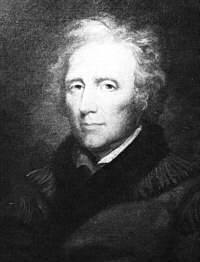
Daniel Boone remains a very important figure in American history. But his fame as an early American folk hero and fictional character has often hidden the true details of his life. He became a legend largely because of John Filson's book, "The Adventures of Colonel Daniel Boon." This book was first published in 1784. It was meant to encourage people to move to Kentucky. The book was translated into French and German, making Boone famous in America and Europe. Filson's book was based on interviews with Boone. It mostly told true stories of Boone's adventures from his exploration of Kentucky through the American Revolution. Filson's book made Boone one of the first popular heroes of the United States.
Timothy Flint also interviewed Boone. His book, Biographical Memoir of Daniel Boone, the First Settler of Kentucky (1833), became a bestseller. Flint added exciting details to Boone's adventures. For example, in Flint's book, Boone fought a bear and escaped from Native Americans by swinging on vines. Even though Boone's family thought the book was silly, Flint's stories greatly influenced how people saw Boone. These tall tales were repeated in many dime novels and books for young boys.
Boone as a Symbol
Thanks to Filson's book, Boone became a symbol of the "natural man." This was someone who lived a good, simple life in the wilderness. The poet Lord Byron famously wrote about Boone in his poem Don Juan (1822). Byron's poem praised Boone as someone who found happiness by turning away from civilization. Many folk tales also showed Boone as a man who moved to more remote areas whenever society got too close. A common story says that when asked why he was moving to Missouri, Boone replied, "I want more elbow room!" However, Boone himself disagreed with this idea. He said that "the circulation of absurd stories that I retire as civilization advances" made his old age bitter.
At the same time, Boone was also seen as a trailblazer for civilization. He was celebrated as someone who helped with Manifest Destiny. He was a pathfinder who tamed the wilderness, making way for American civilization to expand. In 1852, critic Henry Tuckerman called Boone "the Columbus of the woods." He compared Boone's journey through the Cumberland Gap to Christopher Columbus's voyage to the New World. In popular stories, Boone became the first to explore and settle Kentucky. He opened the way for countless others. In reality, other Americans had explored Kentucky before Boone. But Boone came to represent all of them. This made him what historian Michael Lofaro called "the founding father of westward expansion."
In the 1800s, when Native Americans were being moved from their lands to reservations, Boone's image was sometimes changed. He was shown as a tough, Native American-hating frontiersman, which was a popular stereotype then.
Remembering Daniel Boone
Many places in the United States are named after Boone. These include the Daniel Boone National Forest in Kentucky and the Sheltowee Trace Trail in Tennessee. His name has long been linked with the American outdoors. The Boone and Crockett Club is a conservation group started by Theodore Roosevelt in 1887. The Sons of Daniel Boone was an early group that led to the Boy Scouts of America. A half-dollar coin was made in 1934 to celebrate 200 years since Boone's birth. A special stamp was issued in 1968. In 1961, the US Navy named a ballistic missile submarine the USS Daniel Boone. Its motto, "New Trails to Blaze," honored Boone's life and his legacy of exploration.
Boone's adventures, both real and fictional, created the image of the American West's hero. This hero was popular in 19th-century novels and 20th-century films. The main character in James Fenimore Cooper's Leatherstocking Tales, Nathaniel Bumppo, was very similar to Boone. The Last of the Mohicans (1826), Cooper's second Leatherstocking novel, includes a fictionalized version of Boone rescuing his daughter. After Cooper, other writers developed the Western hero, an iconic figure that started as a version of Daniel Boone.
In the 1900s, Boone was featured in many comic strips, radio shows, novels, and films. These included the 1936 film Daniel Boone and the 1956 Daniel Boone, Trail Blazer. Boone was also the subject of a TV series that ran from 1964 to 1970. The theme song for the series described Boone as a "big man" in a "coonskin cap" and the "rippin'est, roarin'est, fightin'est man the frontier ever knew!" However, the real Boone was not a big man and did not wear a coonskin cap, which he found uncomfortable. He was shown this way in the TV series because Fess Parker, the tall actor who played him, was also known for playing Davy Crockett. This shows how Boone's image was changed to fit popular tastes.
Images for kids
See also
 In Spanish: Daniel Boone para niños
In Spanish: Daniel Boone para niños
- Boone Trail, a historic trail
- Boone's Cave Park
- Daniel Boone Homestead
- Edward Morgan Log House
- Thomas S. Hinde, a friend of the Boone family


